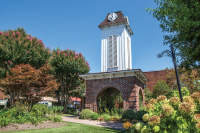Investing in the region’s creative minds
 When the city of Asheville decided that this year’s Bele Chere street festival would be the last it funded, little more than a whisper of protest was reported in the local media. The monstrous festival had become a victim of its own success. The largest street party in the Southeast cost nearly half a million dollars of taxpayer money each year, took just as much time to plan, and then during the summer buildup needed weeks of preparation. Many long ago decided it had become too big to enjoy.
When the city of Asheville decided that this year’s Bele Chere street festival would be the last it funded, little more than a whisper of protest was reported in the local media. The monstrous festival had become a victim of its own success. The largest street party in the Southeast cost nearly half a million dollars of taxpayer money each year, took just as much time to plan, and then during the summer buildup needed weeks of preparation. Many long ago decided it had become too big to enjoy.
Bele Chere may survive under the auspices of some other entity other than the city government, a move that would be helpful to the nonprofits that depend on it for a significant portion of their fundraising. The downtown association is a likely candidate, while the city could still help with security and garbage, writes Jason Sandford, the creator and writer of the blog Ashvegas.
As Bele Chere stares down an uncertain future, though, it has been recommended that Asheville hire a “creative economies director” that would work under the auspices of the economic development office. That’s an idea worth pursuing and one the entire region could perhaps emulate.
The arts attract tourists, create jobs and stimulate economic investment from entrepreneurs who want to live in a culturally rich community. Instead of Asheville spending its tax money on someone who would simply put on festivals or events, it will try to hire someone to leverage the community’s creativity and talent.
Anyone who lives in this region or visited here knows that the arts — music, dance, craft, visual arts, literature — have a special place in the fabric of the WNC community. We raise many of our own artists, and creative souls from across the country have always been attracted to this region. Much has been done to capitalize on this phenomenon, and the benefits reach into our education system, to our downtowns and ripple throughout the economy.
Related Items
But the exciting part of what Asheville is considering is that the recommendation is for this position to be part of the economic development office. For too long the arts have been treated like a cute but impatient child, getting a pat on the head and smile from the political leaders but seldom real recognition — or taxpayer investment — for what it contributes to the economy.
A 2012 Arts and Economic Prosperity study pegs the arts as a $140 million industry in our region. They support 4,655 full-time jobs, while audience spending accounts for $60 million of that total. That’s real money spent in restaurants, hotels, galleries, music halls, theaters, convenience stores, and more.
This conversation about creative economies should also include a technological component. Designers and artists work all over the digital media these days, and supporting the “creative economy” means we will also appeal to software engineers and code writers who support these industries.
In addition, perhaps no other industry also keeps dollars local. Money spent on the arts — by its very nature — stays right here, creating direct benefits and cultural enrichment.
A look around Western North Carolina shows that local governments still spend almost all their economic development money chasing old school manufacturers and bigbox chains, spending money on site work and buildings. The state offers tax breaks to large companies but do little for the small entrepreneur. Elected leaders need to have a more open mind about what is the best way to encourage economic development, especially in a region know for its individuality and creativity.
Helping local arts organizations directly or hiring someone who could seek grant funding or organize multi-day events just makes sense. A creative economies director could also develop ways to bring different cultural and arts organizations together to showcase their product. In most cases, the investment would be far less than what is spent on traditional economic development.
A couple of weeks ago, we reported on the fact that Haywood commissioners had to cut funding to nonprofits as it struggled to keep county workers on the payroll and pay for vital services. That move was born out of the necessity of the recession, and no one can blame them for tightening their belts and hunkering down like everyone else in order to make it through the tough times.
As the economy begins to strengthen, though, Haywood and other local governments should look for innovative ways to build on the creative economy infrastructure that is already in place in our communities. It’s a natural fit in WNC, and one that could forever stamp this region as one of the most culturally rich regions in the U.S. Let’s keep an eye on Asheville as it takes the first steps into this arena.
(Scott McLeod can be reached at This email address is being protected from spambots. You need JavaScript enabled to view it..)









